| HOME |
| Hotels |
| Apartments |
| Attractions |
| Restaurants |
| Tickets & tours shop |
| Tours |
| Maps & travel planners |
| Airports & transport |
| Maps |
| Events |
| Shopping |
| Contact us |
|
| Pictures Gaudi Crypt Colonia Güell |
Pictures Gaudí crypt at Colonia GüellThe Gaudí Crypt in Colonia Guell is an partially completely church in Santa Coloma de Cervelló which is near Barcelona. It was designed by Spanish/Catalan modernist architect Antoni Gaudí. The crypt at Colonia Guell is a lesser known, but still significant Gaudí project and yet another one he never finished. Gaudí was commissioned in 1898 to build by his patron and good friend Eusebi Güell. The church was part of the Colonia Guell factory village for the workers at the Colonia Guell factory, which Guell established in Santa Coloma de Cervelló in 1890. The factory and village was finished but only the crypt of the church was ever built and therefore it's known today as 'The Crypt in Colonia Güell.'How to get to Colonia Guell Santa Coloma de Cervelló is 25 km from the centre of Barcelona by car. It takes half an hour to get there by car or by train from the station at Plaza Espanya.   Work on the church commenced in 1908 and continued until 1914. Then funding was stopped and Gaudí abandoned the project. During that time Gaudí had only completed the crypt.  Today the crypt stands essentially as it did when finished. Some restoration work has been done to remove later alterations that were not included in Gaudí’s original designs. Gaudí even designed the church pews and like all his later work, they reflected his belief that nature is the best model.  The original plans and models reveal designs by Gaudí that would were audacious and innovative for the period, and especially for an industrial estate in the countryside outside Barcelona. 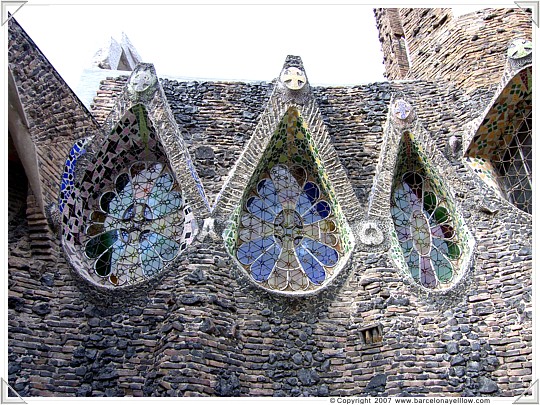 The funding for the construction was stopped in 1914 by the Guell family. Perhaps because they considered the church to grand for factory workers at the turn of the century.  The crypt is regarded as a Gaudí masterpiece because it was the first time many of Gaudí’s innovative ideas came together in a single design and it provided both a testing ground and a source of inspiration for the Sagrada Familia project. 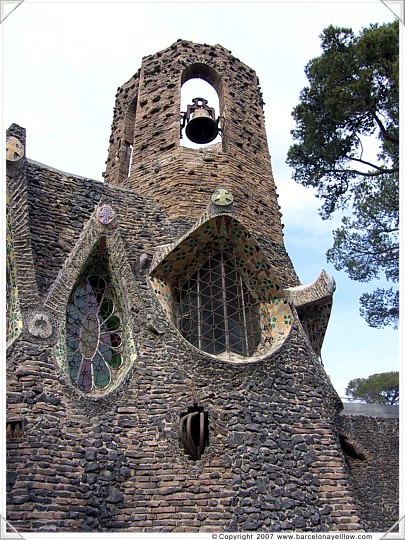 The Crypt in Colonia Güell was innovative in the sheer variety of building materials that Gaudí used including basalt and limestone, brunt ceramic bricks, smelting slag, ceramics, glass and many kinds of mortar. The result is startling and beautiful.  The design for the church was so daring and different that it was not clear how to make the calculations for the constructions. To fix this problem Gaudí devised a exceptional method of architectural projection. It was called a polyfunicular model and was essentially an inverted 3D model of the church design made using weights and strings. Then Gaudí covered with cloth and photographed it. By making large prints of the photographs he was able to make the correct calculations for the inside and outside dimensions of the church. A reproduction of the polyfinicular model can be seen in the museum at the Sagrada Famila in Barcelona. In 1914 when the project was abandoned the roof was covered. The lower nave was blessed by the bishop of Barcelona in 1915 and has been in use for services since then.  Gaudí's fondness for caves is apparent at the Crypt in Colonia Güell 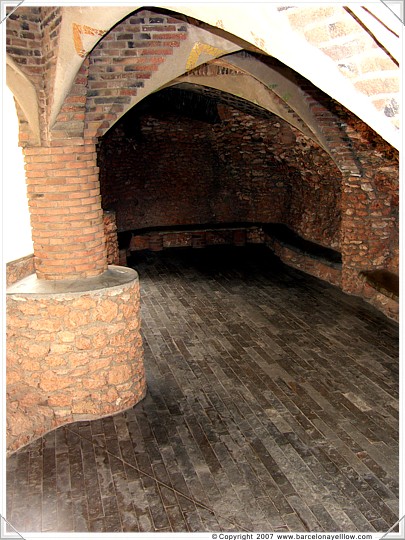 The village of "Santa Coloma de Cervello" remains much the same as it was in Gaudí´s time. The village is not unique in itself, but it is interesting because of the links between Guell and Gaudí. There is a statue of Guell in the village square, which also bears his name. 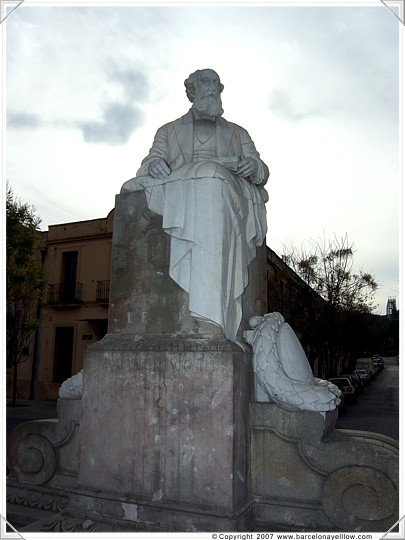 Gaudí himself has a bust near the church surrounded by the nature that he so loved. 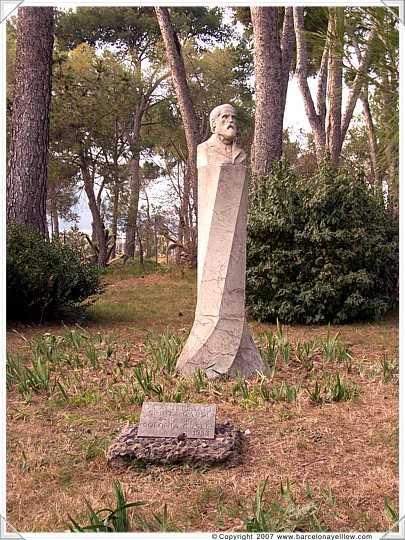 Building factory villages was a popular idea at the end of the 19th century. Many factory owners in industrial countries moved their factories and workers outside the cities to keep workers away from bad socialist influences in the cities. In the case of Colonia Guell the conditions for the workers were much improved compared to their previous life in the city. The project and some of the houses were designed by various modernist architects, although not Gaudí, and were of a high standard. The village itself had everything to give the works a relatively good life. 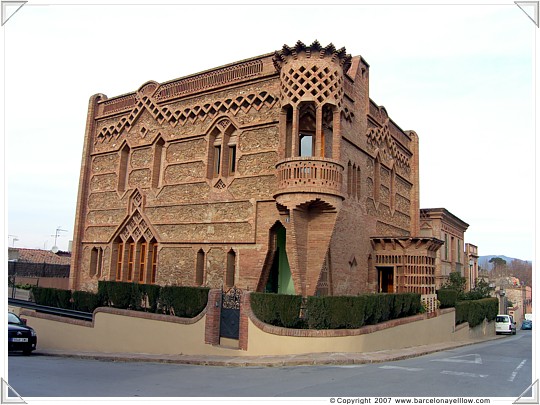 The factory was sold by the Guell family in 1946 but it remained in production as a textile mill up until 1973, when was closed due to competition from countries with cheaper labour. Today the Guell factory has been converted into modern office space for new companies. In recent years a modernist festival has been celebrated every year in Santa Coloma de Cervello to recreate the early days of Colonia Guell. Related pages: About Antoni Gaudí Gaudí buildings in Barcelona Address Colonia Guell Barcelona photo albums © Copyright Barcelonayellow.com Do not copy from this page without permission All rights reserved |
| Last Updated on Thursday, 30 May 2024 13:36 |
|
|
Thursday, 18 September 2025

Barcelona Spain - Barcelona Travel Guide - Copyright 2007-2025
Privacy Policy and Cookies • Legal Disclaimer • Copyright
BarcelonaYellow SiteMap 2025
Barcelona Latest News:
COVID-19 - Barcelona Latest News
Barcelona Safety Guide 2025
Barcelona Top 10 attractions 20254
Plan 3 days in Barcelona 2025
About us
About us
Contact us
Privacy Policy and Cookies
Copyright notice
Legal disclaimer
Twitter Barcelona events
Partnerships
Advertising
COVID-19 - Barcelona Latest News
Barcelona Safety Guide 2025
Barcelona Top 10 attractions 20254
Plan 3 days in Barcelona 2025
About us
About us
Contact us
Privacy Policy and Cookies
Copyright notice
Legal disclaimer
Twitter Barcelona events
Partnerships
Advertising
Accommodation
Hotels in Barcelona
Hotels near Fira Exhibition
Hotels near Camp Nou
Hotels near Cruise Ships
Short Stay Apartments
Practical information
Useful visitor information
How to get to Barcelona airport
Cruise Ship Terminals
Barcelona maps
Airport buses
Barcelona metro
Taxis
Travel cards
Hotels in Barcelona
Hotels near Fira Exhibition
Hotels near Camp Nou
Hotels near Cruise Ships
Short Stay Apartments
Practical information
Useful visitor information
How to get to Barcelona airport
Cruise Ship Terminals
Barcelona maps
Airport buses
Barcelona metro
Taxis
Travel cards
Things to do
Top 10 attractions Barcelona
Photos of Barcelona
Restaurant Guide
Nightlife Guide
Things to do in Barcelona
Barcelona beaches
Book tours and tickets
Skiing near Barcelona
Weather Barcelona
Weather in Barcelona
5 day forecast Barcelona
Top 10 attractions Barcelona
Photos of Barcelona
Restaurant Guide
Nightlife Guide
Things to do in Barcelona
Barcelona beaches
Book tours and tickets
Skiing near Barcelona
Weather Barcelona
Weather in Barcelona
5 day forecast Barcelona
Top Festivals and events
Barcelona Events 2025
Christmas in Barcelona
New Years Eve 2025
MWC 2025 Barcelona
Sant Jordi's Day
Barcelona Marathon
Barcelona Half Marathon
Easter
Festa de Gracia
La Merce Festival
FC Barcelona calendar
Barcelona Events 2025
Christmas in Barcelona
New Years Eve 2025
MWC 2025 Barcelona
Sant Jordi's Day
Barcelona Marathon
Barcelona Half Marathon
Easter
Festa de Gracia
La Merce Festival
FC Barcelona calendar
Moving to Barcelona
Moving to Barcelona
Long term apartment rentals
Relocation agencies
Real estate agencies
Spanish schools
Meeting people
Finding work
Yellow pages directory
Partner websites:
DayTripsBarcelona.com
Stepbac.com
PhotoMemoirs.co
Helpfurl.com
Moving to Barcelona
Long term apartment rentals
Relocation agencies
Real estate agencies
Spanish schools
Meeting people
Finding work
Yellow pages directory
Partner websites:
DayTripsBarcelona.com
Stepbac.com
PhotoMemoirs.co
Helpfurl.com
